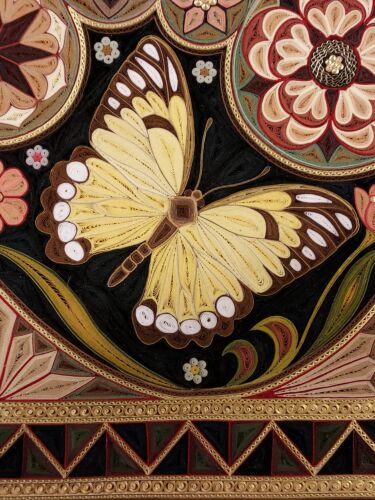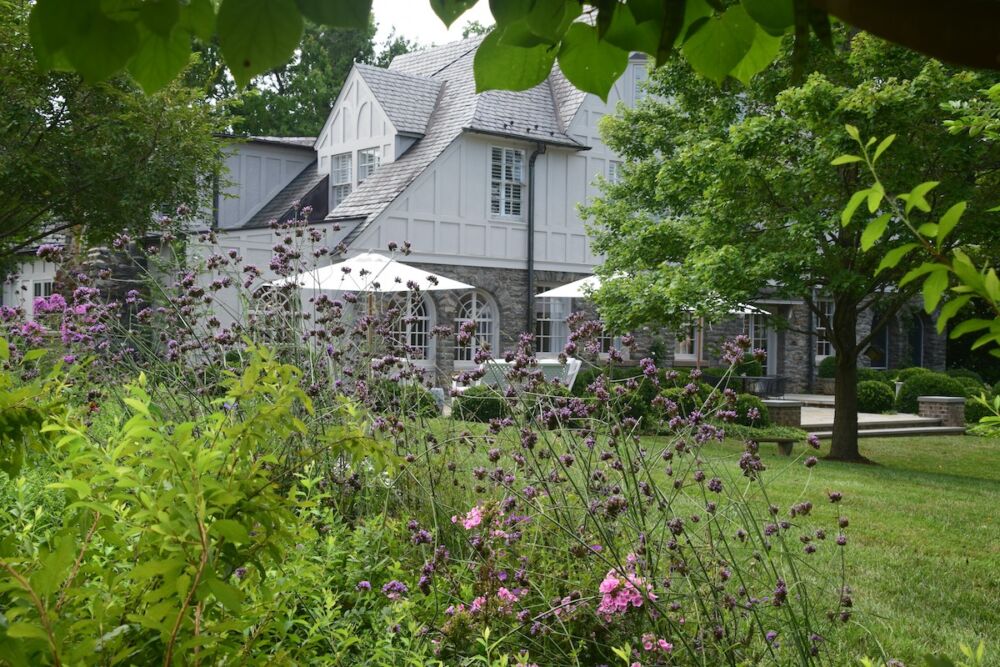[vc_row][vc_column][vc_column_text]Paper quilling—aka paper filigree—is an artistic medium that uses coiled paper to create intricate designs, images, and sometimes messages. The artist starts by wrapping a piece of paper around a small pole to create a curl. Then the artist pinches the curl into the desired shape. The 3D image adds texture and visual interest to elevate simple designs or to create detailed designs. The swirling nature of quilling often lends itself to natural muses, most notably flowers.[/vc_column_text][/vc_column][/vc_row][vc_row][vc_column][vc_single_image image=”261717″ img_size=”large” add_caption=”yes” alignment=”center”][/vc_column][/vc_row][vc_row][vc_column][vc_column_text]
Origins of Quilling
Though the exact origins of paper quilling are debated, the filigree technique is also used with metal and examples of metal filigree have been found in jewelry and other decorative objects from ancient cultures around the Mediterranean, India, and East Asia. Many believe that paper filigree got its roots in Ancient Egypt when papyrus was first invented. It was later picked up by French and Italian nuns during the Renaissance. The nuns used quilling to make expensive-looking designs for religious manuscripts and relics. Instead of commissioning gold metal filigree, they were able to guild the paper, creating an extravagant look without the costly labor and metal goods.[/vc_column_text][/vc_column][/vc_row][vc_row equal_height=”yes” css=”.vc_custom_1693414538607{border-top-width: 1px !important;border-right-width: 1px !important;border-bottom-width: 1px !important;border-left-width: 1px !important;border-left-color: #0a0a0a !important;border-left-style: solid !important;border-right-color: #0a0a0a !important;border-right-style: solid !important;border-top-color: #0a0a0a !important;border-top-style: solid !important;border-bottom-color: #0a0a0a !important;border-bottom-style: solid !important;border-radius: 1px !important;}”][vc_column width=”1/2″][vc_single_image image=”261902″ img_size=”full” alignment=”center” onclick=”custom_link” img_link_target=”_blank” link=”https://quillingcard.com/products/quilled-artist-series-spring-bouquet-renoir-greeting-card?_pos=1&_sid=1d08c81e0&_ss=r”][/vc_column][vc_column width=”1/2″][vc_empty_space][vc_column_text]Quilling Card LLC is the premier source of preserving and sharing the ancient art form of quilling through the development of handcrafted greeting cards. Most notable is their Artist Series collection which recreates iconic works of art into quilled masterpieces available as greeting cards or larger framed works of art. Seen here is Spring Bouquet by Renoir. See more at quillingcard.com.
Sponsored by Quilling Card[/vc_column_text][/vc_column][/vc_row][vc_row][vc_column][vc_column_text]Quilling regained popularity in the 18th century when women from the leisure class started practicing quilling as a hobby along with other crafts such as embroidery and crochet. Since quilling typically lends itself to intricate swirling designs, the craft fit right in with the whimsical Rococo designs of time. It lost its popularity in the West for the next two centuries. It had a brief moment of popularity in the 70s and 80s, but quilling’s largest resurgence has happened in the last decade.[/vc_column_text][/vc_column][/vc_row][vc_row][vc_column][vc_single_image image=”261672″ img_size=”large” add_caption=”yes” alignment=”center”][/vc_column][/vc_row][vc_row][vc_column][vc_column_text]Quilling is a very approachable craft. The skills are relatively easy to master compared to other art forms, and the materials are typically affordable and easily accessible. The repetitive nature of coiling the paper can make it a meditative experience, not to mention a fun and simple way to elevate a birthday card.[/vc_column_text][/vc_column][/vc_row][vc_row][vc_column][vc_column_text]
Contemporary Quilling Artists
[/vc_column_text][/vc_column][/vc_row][vc_row][vc_column][vc_column_text]

BUTTERFLY (detail from GRAND JARDIN) | by Lisa Nilsson | 2022
Though quilling is extremely popular for adding to notecards, it can be used to create a variety of pieces including jewelry, picture frames, and phone cases. There are some that have mastered the craft so well that they’ve elevated quilling to fine art. The medium of quilling is especially useful for artists trying to convey texture or for artists that like to blur the lines between 2D and 3D images like contemporary master Lisa Nilsson. In her series “Tissue,” she uses quilling to create anatomical images. The quilling raises the patterns into a 3D image, giving it a likelike fabric. In her “Tapis” series, which took six years to complete, she uses quilling to create tapestries that echo the patterns of Persian rugs and wallhangings. By using quilling, she took a three-dimensional medium to create a two-dimensional image, much like rugs and tapestries do.[/vc_column_text][/vc_column][/vc_row][vc_row][vc_column][vc_single_image image=”261708″ img_size=”large” add_caption=”yes” alignment=”center”][/vc_column][/vc_row][vc_row][vc_column][vc_column_text]Artist Yulia Brodskaya uses quilling to celebrate nature and people and where they intersect. Unlike Nilsson who uses muted tones to convey reality, Brodskaya uses bright colors to play with the viewer’s idea of fantasy. Her portraits best capture her signature style. She uses blues and purples to portray human skin instead of beiges and browns. She overlays them with natural elements such as butterflies and flowers. Her pieces dedicated exclusively to flowers are cheerful and whimsical. She uses the direction of the paper to suggest the direction of a paint stroke. This is best seen in her work that imitated Van Gogh’s “Irises.” Just like the original, the distinct direction of the paper in her piece conveys movement.[/vc_column_text][/vc_column][/vc_row][vc_row][vc_column][vc_single_image image=”261732″ img_size=”large” add_caption=”yes” alignment=”center”][/vc_column][/vc_row][vc_row][vc_column][vc_column_text]
Collecting Quilling
Quilling is a great way to add variety to any art collection. Since the medium is going through a renaissance of its own right now, there’s no shortage of artists that are testing the reimagined frontier. If you’re considering collecting quilled pieces, keep in mind that they require custom framing since the art is three dimensional. There are lots of different holes to catch dust and dirt, so leaving the piece unframed could lead to damage and cause the paper to break down prematurely. Care for quilled paper as you would other paper arts. Limit light exposure. Protect pieces from heat and humidity. Proper matting can protect quilled works from being creased or worn.
The stationery is an excellent place to start a collection. Not only do they have handcrafted cards and ornaments, but some pieces are true artworks. Quilling Card has a series of famous paintings that have been translated into quilling. Other contemporary masters include Stacy Bettencour and Veta Sherman, and many more can be found on Etsy for commission or pre-made works. For those of you who’d like to try yourself, you can start quilling with little to no real tools—just paper and a pencil to wrap it around, though your local craft store will have plenty of tools to help you achieve your goals. Whether collecting or creating, it is exciting to see an ancient practice come into its own in the 21st century.[/vc_column_text][/vc_column][/vc_row][vc_row][vc_column][vc_separator][/vc_column][/vc_row][vc_row][vc_column][vc_column_text]By Carrie Clay
To see more from the artists above, go to their website or follow along on Instagram!
- Stacy Bettencourt- quantumartistic.com ; @quantumartistic
- Lisa Nilsson- lisanilssonarts.com
- Yulia Brodskaya- artyulia.co.uk ; @yulia_brodskaya_artyulia
More Works on Paper
[/vc_column_text][/vc_column][/vc_row]




